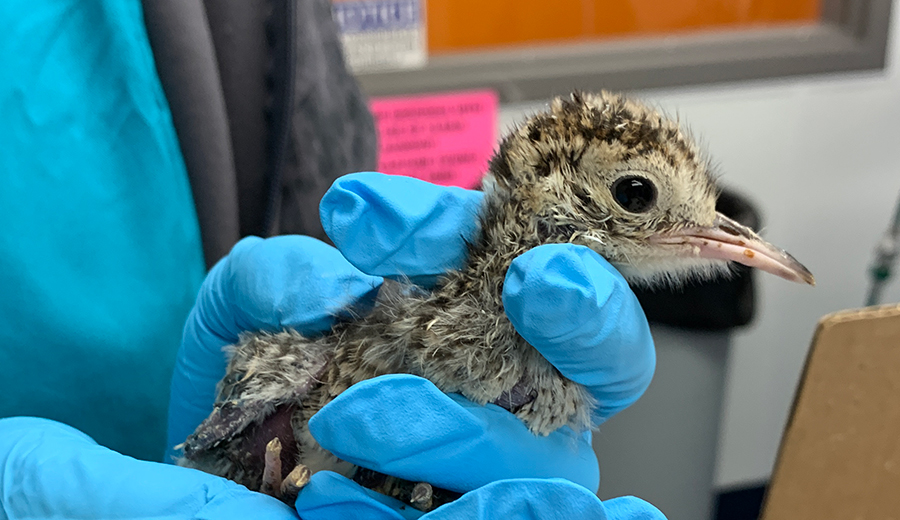Advice on Housing, Feeding, Protecting
Hedgehogs are not tiny cats or spiny hamsters. Before getting a hedgehog as a pet, you need to understand their unique needs so you can keep it healthy and happy. Luckily, Dr. Spencer Kehoe, the newest veterinarian on the zoological medicine service at the University of Illinois Veterinary Medicine South Clinic, is eager to share his advice.
Dr. Kehoe earned his veterinary degree from the University of California-Davis. He then completed a specialty internship in wildlife medicine, surgery, and conservation at the Clinic for the Rehabilitation of Wildlife (CROW) in Sanibel, Fla, and a three-year zoological medicine and surgery residency at the University of Georgia.
“I love teaching, mentoring, and getting to work with students, specialty interns, and residents to provide the best care possible for the amazing species our service sees,” says Dr. Kehoe of his new role. “I also enjoy being in an environment where I can challenge myself and learn from my colleagues every day.”
And speaking of challenging, a hedgehog can be a demanding pet, so learn all you can before you bring one home.
Where to Keep Your Hedgehog
Dr. Kehoe recommends using a solid-sided cage, such as a glass aquarium, so your hedgehog can’t climb up the walls, which not only could lead to their escape, but also leads to damaging their toes.
“As long as the bottom 12 inches of the walls are solid to prevent climbing, a wire-sided cage could be used,” he notes. “Hedgehogs are normally quite active, so the floor of the cage should be at least 2 feet by 3 feet to give them plenty of room to roam. And they are nocturnal, so they are going to be active at night.”
Dr. Kehoe also advises having only one hedgehog per enclosure. “Hedgehogs are solitary in the wild and may fight if housed together,” he warns.
Bedding for your hedgehog should be soft and absorbent. Recycled newspaper bedding is preferred, and aspen wood shavings are acceptable, but do not use other wood chip products that are aromatic, such as cedar, or dusty materials. These can irritate the respiratory tract and predispose it to infection.
What to Put in the Enclosure
“Bedding will need to be changed frequently. I recommend daily spot cleaning to remove feces, a midweek change of bedding, and a thorough cage cleaning (everything removed and the cage washed) at the end of each week,” says Dr. Kehoe.
Their cage should offer a place to hide and sleep during the day. “Options include a box, a ‘hut’ purchased from a pet store, or a length of PVC pipe,” says Dr. Kehoe. “Be sure the hiding spot has no sharp edges and has a big enough entryway that the hedgehog does not get stuck.”
Hedgehogs need a warm environment. Dr. Kehoe recommends having at least two thermometers inside the pet’s enclosure to ensure that the temperature range stays between 75°F and 85°F.
“If the temperature goes outside this range, the hedgehog may enter a state of torpor where it becomes less active,” says Dr. Kehoe. “This situation also negatively impacts the animal’s immune function.”
What to Feed Your Hedgehog
Hedgehogs are considered insectivores. In the wild they eat insects and other invertebrates, eggs, vegetation, and on occasion small vertebrates.
“The best diet for your hedgehog is a commercially formulated diet specifically made for hedgehogs, or an insectivore diet,” advises Dr. Kehoe. “Never feed your hedgehog food marketed for cats or ferrets because these diets are too high in protein and fat and far too low in fiber.”
You can supplement your hedgehog’s commercial food with a variety of invertebrates, such as crickets, earthworms, and mealworms, that have been fed a diet rich in calcium, a practice called “gut loading.” Pet stores carry these supplements for the invertebrates.
Hedgehogs should also be given a variety of vegetables, such as beans, cooked carrots, squash, peas, tomatoes, and leafy greens. Dr. Kehoe warns that only very small amounts of fruits—less than ¼ teaspoon per day—should be offered as treats. Fruits are high in sugar.
Fresh water should be always available in a shallow pan and changed daily. No additives are needed for your hedgehog’s water.
Exercise and Veterinary Care for Your Hedgehog
In the wild hedgehogs are good swimmers and agile climbers. They may run several miles a night. In captivity, they need an enclosure large enough to allow for natural foraging behavior. Dr. Kehoe recommends providing an exercise wheel, but the wheel must have a solid bottom, not a wire one, which can lead to severe injuries such as broken legs.
“Since hedgehogs are nocturnal, nighttime is the best time to interact with your pet,” says Dr. Kehoe. “Interaction is mentally stimulating for your hedgehog and allows them to become more comfortable with you and with handling.”
One warning about handling hedgehogs, though: hedgehogs can carry the salmonella bacteria without showing any symptoms. Salmonella causes a disease in humans and animals with the symptoms of diarrhea, weight loss, and dehydration. This disease can be fatal if left untreated. For this reason, it is very important to use caution and wash your hands after handling your pet.
Hedgehogs typically live 4 to 6 years, and Dr. Kehoe recommends a veterinary checkup every six months. Common health concerns in hedgehogs include obesity, fatty liver disease, cancer, wobbly hedgehog syndrome, skin disease, and dental disease. Unspayed female hedgehogs can also develop reproductive diseases. Obesity and fatty liver disease can be prevented by giving your pet a proper diet and plenty of exercise.
If you have questions about hedgehogs or other pets, please see your local veterinarian.
By Crystal Munguia
Photo by Arif Hidayat on Unsplash

![[pet hedgehog]](https://vetmed.illinois.edu/wp-content/uploads/2021/04/pc-kehoe-hedgehog.jpg)


